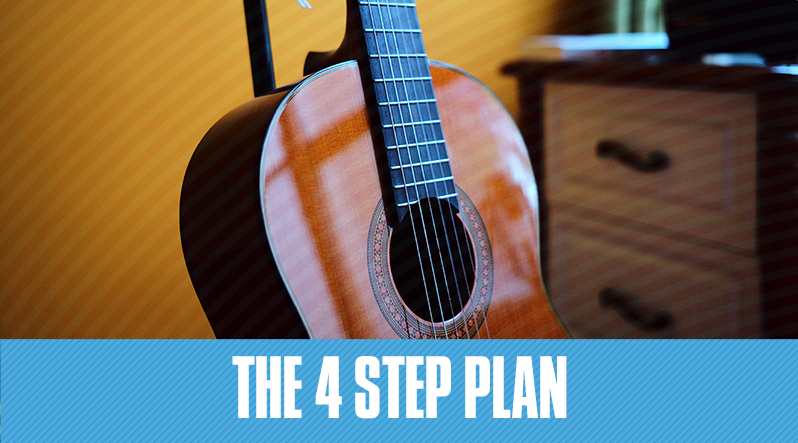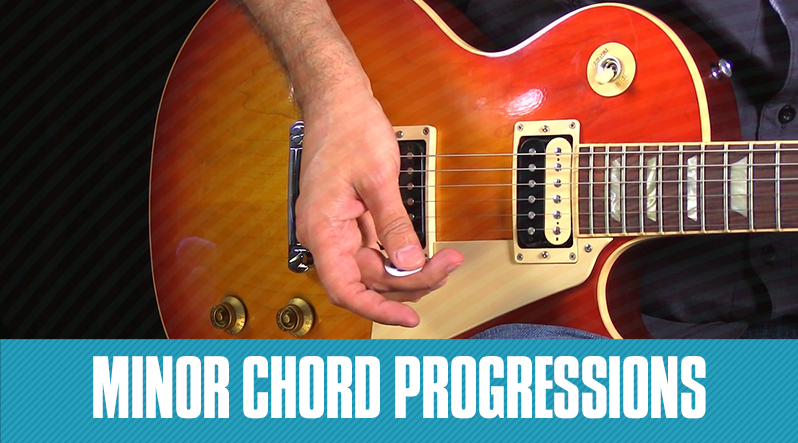Power chords are often used in rock music and are to learn for anyone taking beginner guitar lessons.
They're also called fifth chords because they're made from the root note and the fifth.
They’re beefy, often crunchy and are super simple to play because it takes only three notes to make these types of guitar chords.
Here are 5 easy steps to learning and practicing these powerful chords.
1. There are only 3 Notes
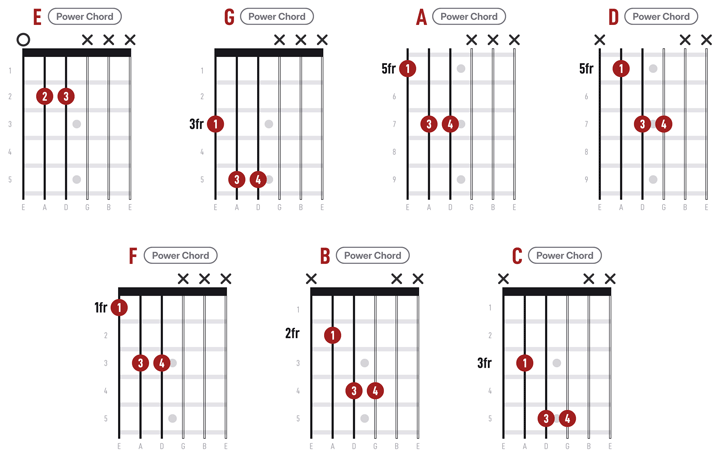
Guitarists often play these types of chords with the root note on the low E string and the A string.
For this example, we’ll use the low E string.
With your 1st finger, hold down the root note, and then follow this with your 3rd and 4th finger to hold down the other two notes.
This is an F major power chord because the root note is on the first fret of the low E string.
Playing the F power chord can feel a bit like a rite of passage.
Here’s the catch: since you’re closer to the nut (that’s the little bar at the end of the fretboard), the strings are a bit tighter making them harder to press down.
But don’t let that scare you.
With a bit of practice, you’ll be nailing that F power chord in no time.
If you want to look at these shapes a bit more, check out a guitar chord chart for every variation possible.
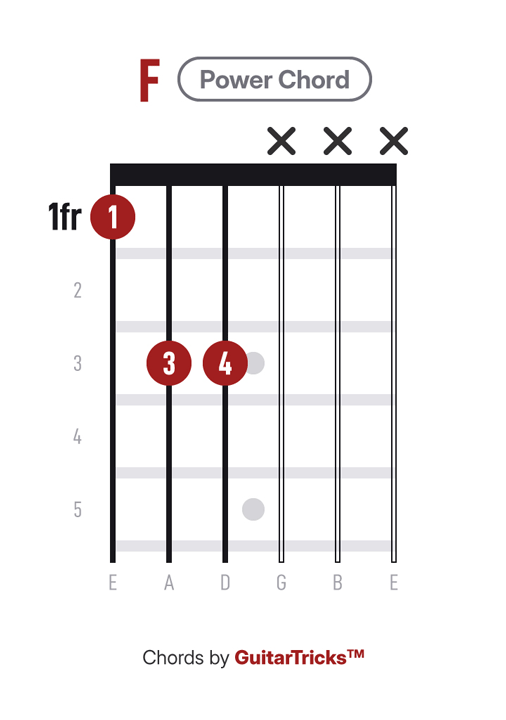
2. Power Chords are Moveable
If you take the above chord shape and move it to the 5th fret, it will become an A major power chord, because the 5th fret of the low E string is an A note. 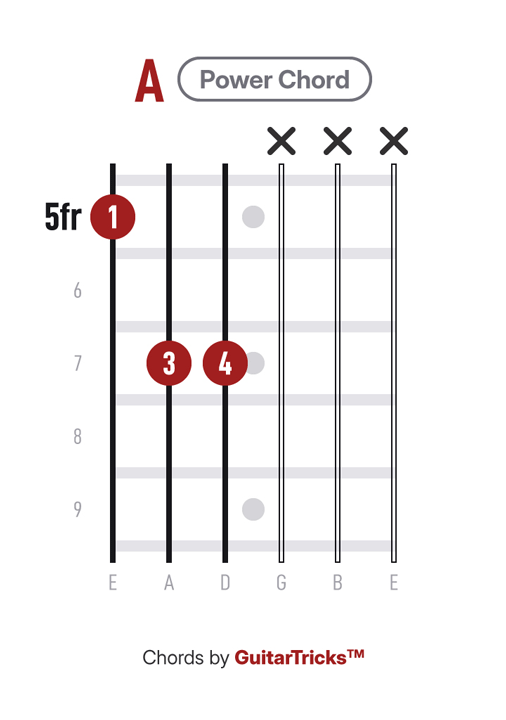
The A power chord is much easier than the F power chord since it's on the 5th fret.
Simply place your index finger on the 2nd fret of the D string.
That's your root note, A.
Then, pop your ring finger on the 4th fret of the G string.
Strum those two strings together, and boom, you're playing an A power chord!
This chord is incredibly versatile and will get you through a ton of rock and punk classics.
3. Power Chords Work on the 5th String, Too!
The same 3-note power chord shape can be used on the 5th string as well, or if you’re in standard tuning, the A string.
All the same rules apply as before.
The fret that you’re holding with your 1st finger is the root note, which will determine the chord you’re playing.
Take a look at this D major power chord. 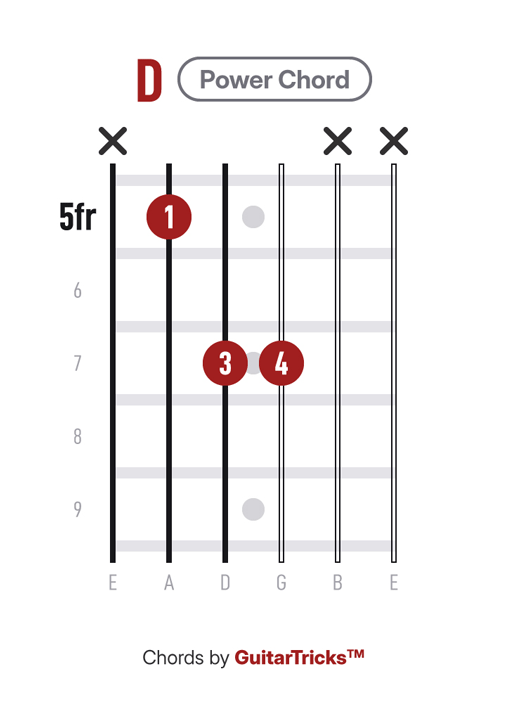
It’s a D power chord because the 1st finger is holding a D note on the 5th string.
4. Remember to Palm Mute
Now that you know how to hold the chord shape, it’s time to actually put it to some use.
Power chords can sound really great if you’re playing them correctly.
When you’re strumming these types of chords, it’s important to palm mute so that the other strings don’t ring out.
If they do, your chord progression will end up sounding way too loud and garbled.
5. Practice with Songs
One of the best ways to practice any new guitar technique is to try it in a song.
Luckily, Guitar Tricks has tons of easy guitar songs you can use to practice your power chords with.
Power chords are easy, they’re versatile, and they’ll make you sound like a rock legend, even if you’re just starting out.
Next Level Power Chords
Guitar pedals can elevate your sound from 'garage band' to 'stadium tour' in a heartbeat.
Slam on a distortion or overdrive pedal to give your power chords that gritty, in-your-face punch.
Add some reverb or delay for an atmospheric vibe that can turn a simple progression into a sonic landscape.
Play around with modulation effects like phaser or flanger to add a swirling, trippy character which can help add some complexity and depth to these otherwise simple chords.
The key is to start simple and experiment – each pedal can turn the same few chords into a whole new experience.
The best part about power chords is they make getting started on guitar so quick!
So grab your guitar and get ready to bring the house down.
FAQ
How do you play a power chord A?
To play an A power chord, you'll want to place your index finger on the 5th fret of the sixth (E) string.
That's your root note, A.
Then, put your ring finger (or pinky, whichever feels better) on the 7th fret of the fifth (A) string.
That's your fifth, E.
Just play these two strings, and you've got yourself an A power chord!
What notes are in an A power chord?
An A power chord consists of two notes: A (the root note) and E (the fifth note).
Simple, right? Just those two, making sweet, powerful music together.
Is an A power chord a 5th?
Yes, you've got it!
An A power chord is also known as an A5 because it’s made up of the root note (A) and the fifth note (E) from the A major scale.
What is the F power chord?
The F power chord is played by placing your index finger on the 1st fret of the sixth (E) string - that’s your F note.
Then, your ring finger (or your pinky) goes on the 3rd fret of the fifth (A) string, which is C.
Just like the A power chord, you're playing just these two strings.
What is a power chord?
A power chord is a simplified version of a full chord, using only two notes: the root note and the fifth note from the corresponding scale.
They don’t have a major or minor quality to them, making them super versatile and a favorite in rock and metal music.
Is F the hardest chord?
For many beginners, F can be a challenge because it often requires a barre technique, which can be tough on the fingers.
But we're talking about the F power chord here, which is much easier!
So don't sweat it; with power chords, you’re bypassing the full barre chord terror.
What are the main power chords?
The main power chords are typically those based on the root notes of E, A, D, G, and sometimes B and F.
They can be moved all over the fretboard, so once you've got the shape down, you can play them anywhere!
How many power chords are there?
Technically, there are as many power chords as there are notes because you can play a power chord starting from any note.
So, 12 basic ones considering each semitone in an octave, but countless when you consider all the positions on the fretboard.
What are the rules for power chords?
The main rules for power chords are pretty straightforward: they consist of only the root note and the fifth note.
They don't include the third note so they're neither major nor minor.
Also, keep them clean and tight - avoid strumming other strings to maintain that crisp, powerful sound.
And feel free to move the shape up and down the fretboard to play different chords.
That's the beauty of power chords; they're super flexible!
